Application Questions and Problems
Introduction
Question 19.24
The introduction to this chapter explains how gene therapy is used to treat Leber congenital amaurosis (LCA, a type of severe blindness). What characteristics of blindness that affect the retina (such as LCA) make it an attractive candidate for treatment by gene therapy?
Section 19.2
Question 19.25
Suppose that a geneticist discovers a new restriction enzyme in the bacterium Aeromonas ranidae. This restriction enzyme is the first to be isolated from this bacterial species. Using the standard convention for abbreviating restriction enzymes, give this new restriction enzyme a name (for help, see footnote to Table 19.1).
Question 19.26
How often, on average, would you expect a type II restriction endonuclease to cut a DNA molecule if the recognition sequence for the enzyme had 5 bp? (Assume that the four types of bases are equally likely to be found in the DNA and that the bases in a recognition sequence are independent.) How often would the endonuclease cut the DNA if the recognition sequence had 8 bp?
Question 19.27
A microbiologist discovers a new type II restriction endonuclease. When DNA is digested by this enzyme, fragments that average 1,048,500 bp in length are produced. What is the most likely number of base pairs in the recognition sequence of this enzyme?
576
Question 19.28
Will restriction sites for an enzyme that has 4 bp in its restriction site be closer together, farther apart, or similarly spaced, on average, compared with those of an enzyme that has 6 bp in its restriction site? Explain your reasoning.
Question 19.29
About 60% of the base pairs in a human DNA molecule are AT. If the human genome has 3.2 billion base pairs of DNA, about how many times will the following restriction sites be present?
- a. BamHI (restriction site is 5′–GGATCC–3′)
- b. EcoRI (restriction site is 5′–GAATTC–3′)
- c. HaeIII (restriction site is 5′–GGCC–3′)
Question 19.30
Restriction mapping of a linear piece of DNA reveals the following EcoRI restriction sites.

- a. This piece of DNA is cut by EcoRI, the resulting fragments are separated by gel electrophoresis, and the gel is stained with ethidium bromide. Draw a picture of the bands that will appear on the gel.
- b. If a mutation that alters EcoRI site 1 occurs in this piece of DNA, how will the banding pattern on the gel differ from the one that you drew in part a?
- c. If mutations that alter EcoRI sites 1 and 2 occur in this piece of DNA, how will the banding pattern on the gel differ from the one that you drew in part a?
- d. If 1000 bp of DNA were inserted between the two restriction sites, how would the banding pattern on the gel differ from the one that you drew in part a?
- e. If 500 bp of DNA between the two restriction sites were deleted, how would the banding pattern on the gel differ from the one that you drew in part a?
Question 19.31
Which vectors (plasmid, phage λ, cosmid, bacterial artificial chromosome) can be used to clone a continuous fragment of DNA with the following lengths?
- a. 4 kb
- b. 20 kb
- c. 35 kb
- d. 100 kb
Question 19.32
A geneticist uses a plasmid for cloning that has the lacZ gene and a gene that confers resistance to penicillin. The geneticist inserts a piece of foreign DNA into a restriction site that is located within the lacZ gene and uses the plasmid to transform bacteria. Explain how the geneticist can identify bacteria that contain a copy of a plasmid with the foreign DNA.
Question 19.33
In Figure 19.11, what is the purpose of the neo+ gene that is attached to the Bt gene?
Section 19.3
Question 19.34
Suppose that you have just graduated from college and have started working at a biotechnology firm. Your first job assignment is to clone the pig gene for the hormone prolactin. Assume that the pig gene for prolactin has not yet been isolated, sequenced, or mapped; however, the mouse gene for prolactin has been cloned, and the amino acid sequence of mouse prolactin is known. Briefly explain two different strategies that you might use to find and clone the pig gene for prolactin.
Question 19.35
A molecular biologist wants to isolate a gene from a scorpion that encodes the deadly toxin found in its stinger, with the ultimate purpose of transferring this gene to bacteria and producing the toxin for use as a commercial pesticide. Isolating the gene requires a DNA library. Should the molecular biologist create a genomic library or a cDNA library? Explain your reasoning.
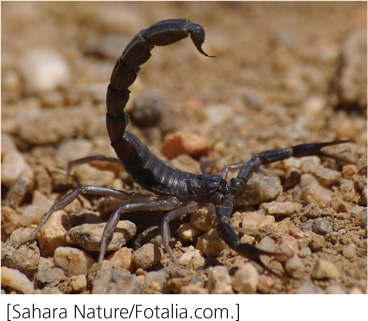
Question 19.36
A protein has the following amino acid sequence:
Met-Tyr-Asn-Val-Arg-Val-Tyr-Lys-Ala-Lys-Trp-Leu-Ile-His-Thr-Pro
You wish to make a set of probes to screen a cDNA library for the sequence that encodes this protein. Your probes should be at least 18 nucleotides in length.
- a. Which amino acids in the protein should be used to construct the probes so that the least degeneracy results? (Consult the genetic code in Figure 15.10.)
- b. How many different probes must be synthesized to be certain that you will find the correct cDNA sequence that specifies the protein?
Section 19.4
Question 19.37
In Figure 19.22 Bob and Joe are each homozygous for different restriction fragment patterns. How many bands would you expect to see on the gel if a person was heterozygous for the A and B patterns? Explain your reasoning.
Question 19.38
Suppose that you want to sequence the following DNA fragment:
5′–TCCCGGGAAA-primer site–3′
You first use PCR to amplify the fragment, so that there is sufficient DNA for sequencing. You then separate the products of the polymerization reactions by gel electrophoresis. Draw the bands that should appear on the gel from the four sequencing reactions.
577
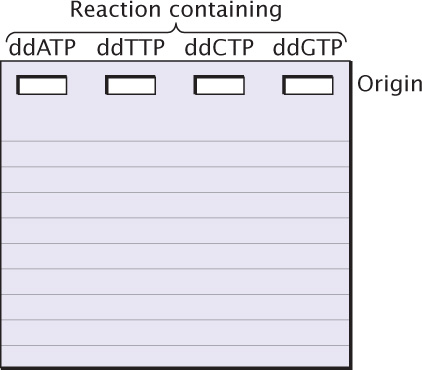
Question 19.39
Suppose that you are given a short fragment of DNA to sequence. You amplify the fragment with PCR and set up a series of four dideoxy reactions. You then separate the products of the reactions by gel electrophoresis and obtain the following banding pattern:

Write out the base sequence of the original fragment that you were given.
Original sequence: 5′-__________________-3′
Question 19.40
 The picture below is a sequencing gel from the original study that first sequenced the cystic fibrosis gene (J. R. Riordan et al. 1989. Science 245:1066–1073). From the picture, determine the sequence of the normal copy of the gene and the sequence of the mutated copy of the gene. Identify the location of the mutation that causes cystic fibrosis (CF). Hint: The CF mutation is a 3 bp deletion.
The picture below is a sequencing gel from the original study that first sequenced the cystic fibrosis gene (J. R. Riordan et al. 1989. Science 245:1066–1073). From the picture, determine the sequence of the normal copy of the gene and the sequence of the mutated copy of the gene. Identify the location of the mutation that causes cystic fibrosis (CF). Hint: The CF mutation is a 3 bp deletion.
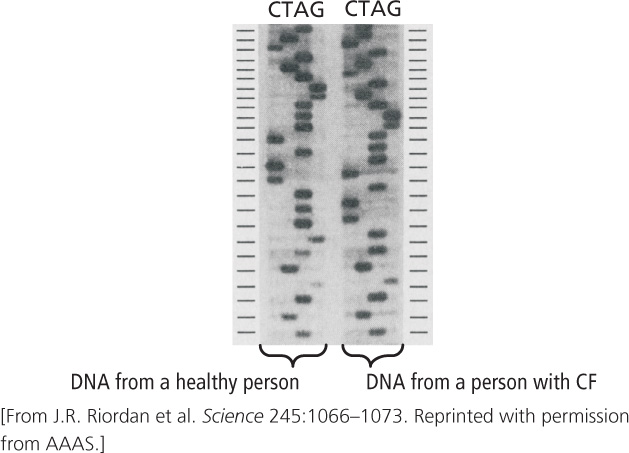
Question 19.41
A hypothetical disorder called G syndrome is an autosomal dominant disease characterized by visual, skeletal, and cardiovascular defects. The disorder appears in middle age. Because its symptoms are variable, the disorder is difficult to diagnose. Early diagnosis is important, however, because the cardiovascular defects can be treated if the disorder is recognized early. The gene for G syndrome is known to reside on chromosome 7, and it is closely linked to two RFLPs on the same chromosome, one at the A locus and one at the C locus. The G, A, and C loci are very close together, and there is little crossing over between them. The following RFLP alleles are found at the A and C loci:
A locus: A1, A2, A3
C locus: C1, C2, C3
Sally, shown in the following pedigree, is concerned that she might have G syndrome. Her deceased mother had G syndrome, and she has a brother with the disorder. Her other brother is middle-aged and does not have the disease; so assume that he does not carry genes for it. A geneticist genotypes Sally and her immediate family for the A and C loci and obtains the genotypes shown on the pedigree.
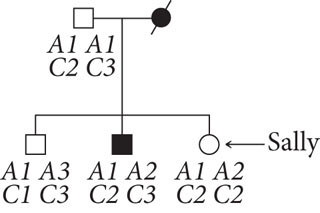
- a. Assume that there is no crossing over between the A, C, and G loci. Does Sally carry the gene that causes G syndrome? Explain why or why not.
- b. Draw the arrangement of the A, C, and G alleles on the chromosomes for all members of the family.
Section 19.5
Question 19.42
You have discovered a gene in mice that is similar to a gene in yeast. How might you determine whether this gene is essential for development in mice?
Question 19.43
Andrew Fire, Craig Mello, and their colleagues were among the first to examine the effects of double-stranded RNA on gene expression (A. Fire et al. 1998. Nature 391:806–811). In one experiment, they used a transgenic strain of C. elegans into which a gene (gfp) for a green fluorescent pigment had been introduced. They injected some worms with double-stranded RNA complementary to coding sequences of the gfp gene and injected other worms with double-stranded RNA complementary to the coding region of a different gene (unc22A) that encodes a muscle protein. The photographs on the next page show larvae and adult progeny of the injected worms. Green fluorescent pigment appears as bright spots in the photographs.
578
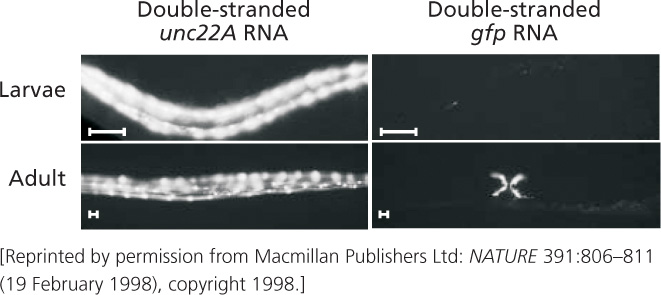
- a. Explain these results.
- b. Fire and Mello conducted another experiment in which they injected double-stranded RNA complementary to the introns and promoter sequences of the gfp gene. What results would you expect with this experiment? Explain your answer.